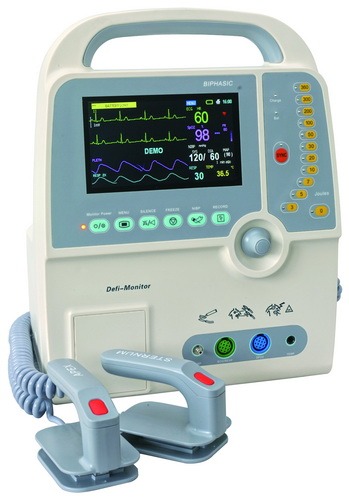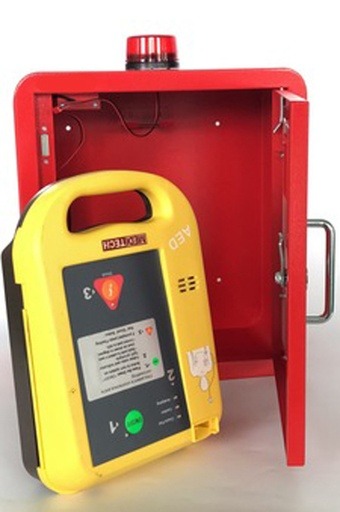In emergencies such as sudden cardiac arrest (SCA), every second counts. When a person’s heart stops beating effectively, they need immediate assistance to survive, and this is where defibrillators come in. In this post, we'll explore everything you need to know about defibrillators, from how they work to frequently asked questions, ensuring you're prepared for any emergency.
1. Introduction: What is a Defibrillator?
A defibrillator is a life-saving device designed to deliver an electric shock to a person’s heart in the event of cardiac arrest. The aim is to restore a normal heart rhythm, which can significantly improve the chances of survival.
There are two main types:
- Automated External Defibrillator (AED): Automatically detects the heart's rhythm and delivers a shock if necessary.
- Public Access Defibrillator (PAD): Located in public spaces for quick access(British Heart Foundation Shop).
According to the British Heart Foundation, defibrillators are crucial in public spaces where cardiac arrests are most likely to occur, such as gyms, offices, and schools(British Heart Foundation Shop).
2. How Does a Defibrillator Work?
A defibrillator works by:
- Assessing the heart rhythm: It detects irregular rhythms.
- Delivering a shock: If needed, the device sends an electrical pulse to reset the heart’s rhythm.
| Device Type | Action Required |
|---|---|
| AED | Fully automatic, administers shock without intervention |
| Semi-automatic AED | Requires the user to press a button to deliver a shock |
CPR and Defibrillators
CPR is essential before and after using a defibrillator. According to studies, combining CPR with defibrillator use doubles the chances of survival, as it helps maintain blood flow while the AED assesses the heart(Direct365).

3. Who Should Use a Defibrillator?
A common myth is that you need to be trained to use a defibrillator. However, modern AEDs are designed for anyone to use, providing voice instructions and visual cues. Whether or not you’re medically trained, the AED will guide you through the process(British Heart Foundation Shop).
Can You Hurt Someone?
Another concern is the fear of using a defibrillator incorrectly and causing harm. However, AEDs are designed to assess the heart rhythm and will only shock if necessary, minimizing any risk of harm(Direct365).
Key Fact: Survival rates drop by 10-15% for every minute defibrillation is delayed(British Heart Foundation Shop). Acting quickly is essential!
4. When and Where to Use a Defibrillator?
Cardiac Arrest vs. Heart Attack:
These terms are often confused. While a heart attack occurs due to blocked blood flow to the heart, cardiac arrest happens when the heart's electrical system malfunctions and stops the heart from beating(British Heart Foundation Shop).
Condition
|
Definition
|
When to Use a Defibrillator?
|
Cardiac Arrest
|
Heart suddenly stops beating effectively
|
Use immediately
|
Heart Attack
|
Blood flow to the heart is blocked
| Usually, not needed |
Public Defibrillators
Many public locations now have AEDs installed, especially in high-risk areas like airports, sports facilities, and schools. Having AEDs in easily accessible areas can significantly reduce response times in emergencies(British Heart Foundation Shop).

5. Common Questions About Defibrillators
Here’s a list of frequently asked questions about defibrillators:
Can Defibrillators Be Used on Children?
Yes, most AEDs have pediatric settings or smaller pads for children under 8 years old(British Heart Foundation Shop).
Can Defibrillators Be Used on the Elderly?
Absolutely. A defibrillator can be used on anyone experiencing cardiac arrest, regardless of age(Direct365).
Can You Use a Defibrillator on Someone With a Pacemaker?
Yes, but it’s important to place the pads away from the pacemaker. AEDs are designed to detect heart rhythms and will function normally(Direct365).
What Happens If I Use a Defibrillator on a Non-cardiac Event?
The AED will not deliver a shock if it doesn’t detect an abnormal heart rhythm. It’s important to remember that using an AED when unsure won’t harm the patient(British Heart Foundation Shop).
6. Maintaining a Defibrillator
Maintaining a defibrillator is simple. Regular checks ensure the device is ready for use in an emergency. Most modern AEDs require:
- Weekly visual checks to ensure the device hasn't been tampered with.
- Replacing the pads and batteries as recommended, usually every 2-5 years(British Heart Foundation Shop).
Lifespan of Components:
| Component | Typical Lifespan |
|---|---|
| Pads | 2 years or after use |
| Battery | 4-5 years |

7. The Future of Defibrillators
As technology advances, defibrillators are becoming more compact, user-friendly, and accessible. We are now seeing portable defibrillators for home use, and as AI technology continues to evolve, future defibrillators may be equipped with even more advanced diagnostic capabilities(Direct365).
Emerging Trends:
- Integration with mobile apps for tracking device location.
- More affordable and accessible devices for home and small businesses.
8. Conclusion: Saving Lives with Defibrillators
Defibrillators are a vital tool in the fight against sudden cardiac arrest, and their availability and ease of use have never been greater. Whether in a public space or your home, knowing how and when to use a defibrillator can mean the difference between life and death. By understanding the basics and busting myths, you can be a part of the movement to save lives.The next time you see a defibrillator in a public space, take a moment to familiarize yourself with it—you might just save a life one day.

→Click here to learn more about our defibrillator
References:
- British Heart Foundation: Defibrillator FAQs
- Direct365: Common Questions About Defibrillators
- Quora: Common Defibrillator Questions